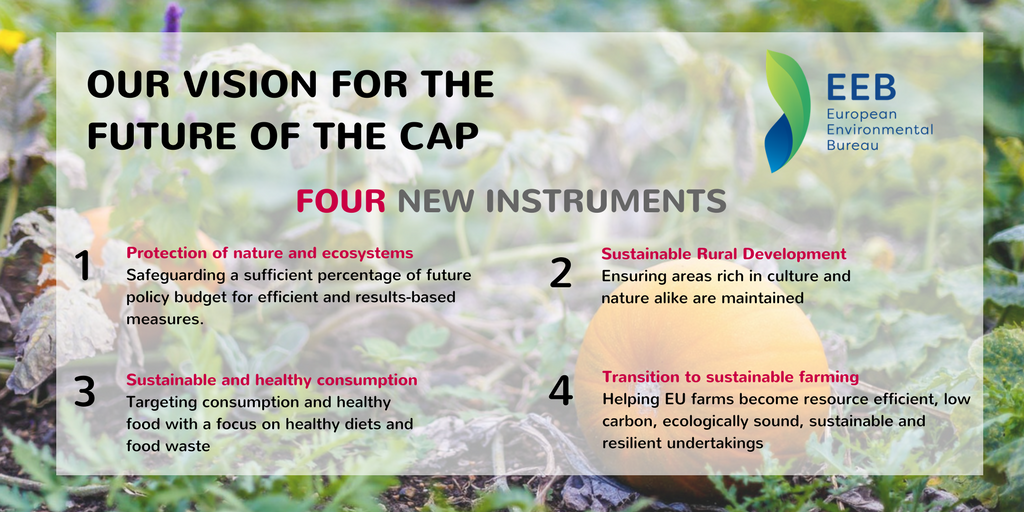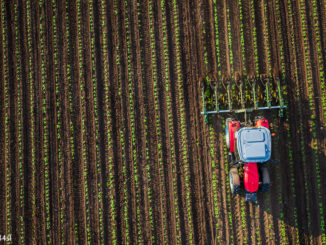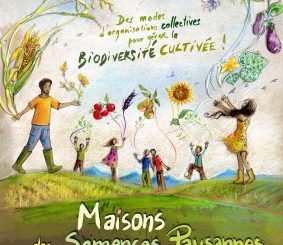Four new policy instruments have been proposed by the EEB – the European Environmental Bureau – for a future CAP. These instruments are put forward for use in the areas of ecosystems, rural development, healthy food and sustainable farming.

The EEB position paper – The future of CAP: An urgent need for a truly sustainable agriculture, land and food policy – suggests the following new instruments for CAP:
1. Protection and enhancement of biodiversity and ecosystems: Safeguarding a sufficient percentage of future policy budget for efficient and results-based measures.
2. Sustainable Rural Development: Ensuring areas rich in culture and nature alike are maintained.
3. Sustainable and healthy consumption: Targeting consumption and healthy food with a focus on healthy diets and food waste.
4. Transition to sustainable farming: Helping EU farms become resource efficient, low carbon, ecologically sound, sustainable and resilient undertakings.
The EEB describes itself as “having around 140 member organisations in more than 30 countries (virtually all EU Member States plus some accession and neighbouring countries), including a growing number of European networks. The EEB represents some 15 million individual members and supporters.”
The document describes the current, CAP supported agri-food system as dysfunctional: “Crises are hitting the farming sector every few months, population decline in rural areas continues unabated, and the effects of climate change are becoming increasingly dramatic. We are constantly losing fertile soils. Excess nutrient loads from agriculture are one of the biggest threats to the EU’s waters, and biodiversity – our precious nature and wildlife – is disappearing before our very eyes.”
While CAP’s greening represents some progress, the “general trends are overarchingly negative” the paper states.
The emphasis should be on “food”, on the “polluter pays principle” and “a new governance structure that allows all the societal interests it affects to be properly involved in the decision making process starting with environmental authorities at all levels” the EEB states.
The EEB also favours abandoning the two pillar structure, and states “respecting the law” should be “the baseline from which to start payments”
A move to a food focus would be more coherent with wider policy goals, which “support the production of healthy and good quality food for EU citizens rather than promoting unhealthy diets through, for example, high consumption of animal products, or unsustainable practices.” Moreover agri-food policy should “provide measurable public benefits to citizens (environment, good/ healthy/high quality food, climate, air, water, soil, biodiversity) with value for money for EU taxpayers”.
Future agri-food policy should be in line with the SDGs (Sustainable Devleopment Goals) and with all the EU’s environmental, climate, animal welfare, and health objectives. This would include “supporting good land management in Europe (i.e integrate the management of land, soil, water and biodiversity and other environmental resources to meet human needs while ensuring the long-term sustainability of ecoystems services and livelihoods)” and helping to “prevent abandonment of socio-environmentally beneficial farming in remote and mountainous areas.”
The position paper shies away from “incentivising excessive risk taking and should not contain publicly financed risk management instruments that insure only private benefits”
The 4 new policy instruments
1 Protection and enhancement of biodiversity and ecosystems
“multiannual programmes/schemes that are targeted, well monitored and result in the provision of various public goods in the form of biodiversity, ecosystem services (e.g. climate, water or soil related) and that can be collectively designed. A major new funding stream is required and such a fund must be primarily developed, programmed and monitored by the competent environmental authorities with the involvement of their agriculture counterparts.”
Comment: this is especially noteworthy as it prioritises environmental authorities, but merely involves agricultural authorities.
2 Sustainable Rural Development
“A dedicated instrument is therefore required in the future policy that seeks to prevent abandonment only where it would have negative social and environmental impacts, and allow for investments in creating an ecologically, socially and economically sustainable future for the rural areas of Europe that are rich in culture and nature alike. Such an instrument would have to be coupled with environmental and social criteria and would critically require a mandatory declaration of household income.”
Comment: While this is a statement against land abandonment, it is qualified.
3 Sustainable and healthy consumption
“We see strong incoherence between production policy and actual changing consumption patterns and demands in the EU The ‘Sustainable and healthy consumption’ instrument could be used for food stamps, promotion measures for healthy diets including less animal products, and increased intake of plant-based foods, setting up of short supply chain mechanisms, recommended dietary guidelines, education in schools for better nutrition, awareness campaigns for healthy diets, local projects in urban areas (urban farming), public procurement, reduction of food waste, and improved transparency and consumer awareness related to environmental, social and health issues.”
Comment: This statement clearly emphaisises the move from a farming to food policy EEB recommend.
4: Transition to sustainable farming
“With the help of the ‘Transition to sustainable farming’ instrument, farms and business should become resource efficient, low carbon, ecologically sound, sustainable and resilient undertakings that are less dependent on chemical inputs and imported fodder and are much more focused on what Europeans want. In such systems, the private and public goods should be easily achievable together and the overall objective should be a far greater independence from the taxpayer than today. A transition process could bring potential benefits to areas with natural or other constraints.
The ‘Transition to sustainable farming‘ instrument should contain the enabling factors that make system change possible through the combination of several measures: one off investments, knowledge transfers, innovation and advice all based on a whole farm approach, supporting local supply chains, organic production and diversified production methods, high environmental and animal welfare standards, the objective of a circular economy and sustainable bio-economy, as well as farm business diversification, encouraging collective approaches, building the immaterial infrastructures such as IT services, and virtual markets.”
Comment: While not using the term agroecology, this instrument would enable a move towards an agroecological agri-food system.





